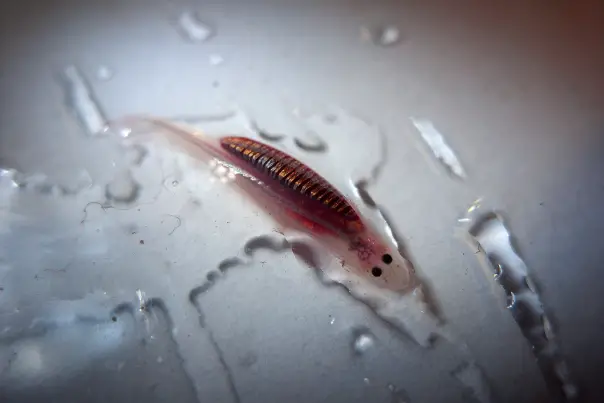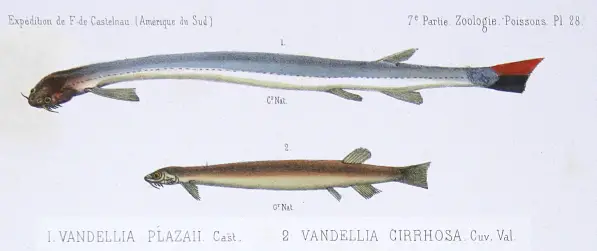‘Phallusy’ or foe? The myth of the candiru

Vandellia species from the rio Tocantins, Brazil engorged with blood from a recent host. © Adam Carvalho
Among the numerous disagreeable ways in which fishes are able to inflict pain and suffering on humans, from the sting of a Corydoras spine to the bite of a white shark, there exists one of which the mere notion has been causing eyes to water for over two hundred years.
The legendary catfish known by the names candiru in Portugese, cañeros in Spanish or wonderfully crude ‘willy fish’ in English has been viewed as a voracious destroyer of manhood since the 19th century when European explorers first returned from the Amazon region with horror stories about a fish with the ability to enter a person’s urethra as he or she relieved themself in the river.
Once there the creature would lodge itself in place using its opercular spines thus making it impossible to remove without considerable force, with the use of pliers, bladder or penis surgery, or amputation of the entire member among the more disturbing ‘remedies’.
The fish has been rumoured to enter the rectum, vagina, or even open wounds, but it’s supposed predilection for the male genitalia has generated by far the greatest horror and fascination.
Indeed, as one author remarked, treatment ‘requires the skills of a physician or, if the man is in a rainforest far from a physician, a machete and a very strong will to live’.
It was said to lurk invisibly in the water until the taste of human urine was detected at which point it would make a bee-line for the source before ‘ascending the length of the liquid column’ and entering the penis itself where it would lay ‘millions of eggs that hatch and devour the bladder’, ‘eat away mucous membranes and tissues until haemorrhage kills the host’ or simply gorge itself on blood.
It’s legend has been furthered by grisly references in contemporary literature from William Burrows’ ‘Naked Lunch’ and ‘The Yage Letters’ to mainstream media including BBC documentaries and the series ‘River Monsters’, and in recent years by the kind of internet sites which tend to promote the cruder varieties of sensationalism.
However, a review of candiru literature by Irmgard Bauer to be published in an upcoming issue of ‘The Journal of Travel Medicine’ suggests the truth to be rather less gruesome, and it appears that tightly-fitting undergarments may no longer be considered quite such an essential item in the backpacks of future Amazon travelers.
The paper begins with a review of internet and other media stories such as those mentioned above before discussing historic tales, and it quickly becomes apparent that much, if not all, of the folklore surrounding it is based on hearsay and repetition of the same accounts by various authors.
References are also made to the likelihood of misinterpretation during exchanges between native tribes and early Amazon explorers, and in translations of accounts from languages such as German, Portugese and French into English.
Other theories presented include the likely exaggeration of candiru rumours by enthusiastic adventurers, or use of the myth by natives in order to dissuade further exploration of their lands.
It’s also made clear that the great explorers of the time such as van Humboldt, Wallace and Bates did not mention the frightful fish at all.
Other problems exist in determining what exactly constitutes a candiru. The name has been applied to a number of species belonging to the catfish family Trichomycteridae, a large grouping restricted to neotropical Central and South America.
Very few of them feed on blood with most having a relatively ordinary, benthic lifestyle, preying on aquatic invertebrates and suchlike.
The most notorious ‘bloodsucking’ species is undoubtedly Vandellia cirrhosa, a member of a small genus containing just three recognised species. It’s a parasite of larger fishes and is thought to be an obligate hematophage, meaning it feeds exclusively on blood, and tends to anchor itself within the gills of its hosts in order to do so.
Although theoretically small enough to fit inside a human urethra and despite being included in the genus Urinophilus (literally ‘lover of urine’) for a number of years, there exists no proof of it being attracted by urine and not a single record of an attack on humans.
Aside from the physical hardship involved in a fish successfully ascending a stream of urine (consider that for a moment) there is the question of what it’s supposed to do once it arrives at its ‘target’.
Wedged inside the urinal tract with no room to move further, no water to keep it alive and deprived of oxygen, it’s difficult to believe it could survive more than a few minutes and surely impossible that it could remain ensconced long term or lay eggs there.

Not all the candiru’s relatives are parasitic. This is Trichomycterus zonatus (Eigenmann, 1918). © Adam Carvalho
In addition, there exist no modern records of a candiru being extracted from the body of a human with the exception of one contradictory report from Brazil in 1997, nor does it appear in the majority of current scientific databases or medical records.
Ony two such references are mentioned in the paper, the first from a survival textbook which recommends treatment with Huito fruit (Genito americana) as per historical texts, the idea being that acids in the fruit dissolve the invader’s skeleton. Application is by drinking a tea made from the fruit or inserting pieces in an unspecified location!
The second was taken from the ‘Lonely Planet’ guide to healthy travel where it’s suggested to ‘cover genitalia’.
In much of the available literature candiru attacks are referred to in such a way that they appear to be a regular, even common occurrence, whereas according to this latest review there exists no substantiated evidence that they happen at all.
For further information refer to the paper: Bauer, I. L. 2013. Candiru—A Little Fish With Bad Habits: Need Travel Health Professionals Worry? A Review. Journal of Travel Medicine.
Matt Ford
Category: Blogs, Myths and legends | Tags: Amazon, candiru, Catfish, parasite, Vandellia, willy fish | Comment »


Product reviewers wanted
Hello! Very much interested in writing for you, please include me in the info. Thank you for the opportunity!
6th Sep 2020
Product reviewers wanted
I would be interested in reviewing products. Before retiring I was a technical writer and managed a Quality Management Program.
30th Aug 2020
Product reviewers wanted
I'm interested and can write reviews from the perspective of someone new to the hobby. I'm only 3-4 months in, but hopefully I can help someone that's...
23rd Aug 2020
Product reviewers wanted
I’m interested in doing this if there is still availability, it sounds like fun! Thanks
19th Aug 2020
Barbodes semifasciolatus – Golden Barb* (Barbus sachsii, Puntius schuberti)
I simply had a question (please forgive if this is not allowed, I read the FAQ but I was not sure). I was wondering if there is any evidence of offsp...
12th Aug 2020